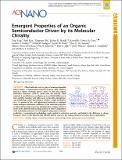Files in this item
Emergent properties of an organic semiconductor driven by its molecular chirality
Item metadata
| dc.contributor.author | Yang, Ying | |
| dc.contributor.author | Rice, Beth | |
| dc.contributor.author | Shi, Xingyuan | |
| dc.contributor.author | Brandt, Jochen R | |
| dc.contributor.author | Correa da Costa, Rosenildo | |
| dc.contributor.author | Hedley, Gordon J | |
| dc.contributor.author | Smilgies, Detlef-M | |
| dc.contributor.author | Frost, Jarvist M | |
| dc.contributor.author | Samuel, Ifor D W | |
| dc.contributor.author | Otero-de-la-Roza, Alberto | |
| dc.contributor.author | Johnson, Erin R | |
| dc.contributor.author | Jelfs, Kim E | |
| dc.contributor.author | Nelson, Jenny | |
| dc.contributor.author | Campbell, Alasdair J | |
| dc.contributor.author | Fuchter, Matthew J | |
| dc.date.accessioned | 2017-09-08T10:30:08Z | |
| dc.date.available | 2017-09-08T10:30:08Z | |
| dc.date.issued | 2017-08-22 | |
| dc.identifier | 250522905 | |
| dc.identifier | a9e2821b-31ef-4551-822b-fd27ffd9e741 | |
| dc.identifier | 28696680 | |
| dc.identifier | 85028459724 | |
| dc.identifier | 000408520900085 | |
| dc.identifier.citation | Yang , Y , Rice , B , Shi , X , Brandt , J R , Correa da Costa , R , Hedley , G J , Smilgies , D-M , Frost , J M , Samuel , I D W , Otero-de-la-Roza , A , Johnson , E R , Jelfs , K E , Nelson , J , Campbell , A J & Fuchter , M J 2017 , ' Emergent properties of an organic semiconductor driven by its molecular chirality ' , ACS Nano , vol. 11 , no. 8 , pp. 8329-8338 . https://doi.org/10.1021/acsnano.7b03540 | en |
| dc.identifier.issn | 1936-0851 | |
| dc.identifier.uri | https://hdl.handle.net/10023/11625 | |
| dc.description | Funding: UK EPSRC (EP/I014535/1, EP/L014580/1, EP/P000525/1, EP/P005543/1, EP/K029843/1, EP/K010298/1, EP/J017361/1 and EP/K016288/1). Raw data files from this study are openly available at DOI: 10.6084/m9.figshare.c.3829771. | en |
| dc.description.abstract | Chiral molecules exist as pairs of nonsuperimposable mirror images; a fundamental symmetry property vastly underexplored in organic electronic devices. Here, we show that organic field-effect transistors (OFETs) made from the helically chiral molecule 1-aza[6]helicene can display up to an 80-fold difference in hole mobility, together with differences in thin-film photophysics and morphology, solely depending on whether a single handedness or a 1:1 mixture of left- and right- handed molecules is employed under analogous fabrication conditions. As the molecular properties of either mirror image isomer are identical, these changes must be a result of the different bulk packing induced by chiral composition. Such underlying structures are investigated using crystal structure prediction, a computational methodology rarely applied to molecular materials, and linked to the difference in charge transport. These results illustrate that chirality may be used as a key tuning parameter in future device applications. | |
| dc.format.extent | 10 | |
| dc.format.extent | 4058230 | |
| dc.language.iso | eng | |
| dc.relation.ispartof | ACS Nano | en |
| dc.subject | Chirality | en |
| dc.subject | Organic semiconductor | en |
| dc.subject | Helicene | en |
| dc.subject | Self-assembling | en |
| dc.subject | Circular polarization | en |
| dc.subject | Structure prediction | en |
| dc.subject | QA75 Electronic computers. Computer science | en |
| dc.subject | QD Chemistry | en |
| dc.subject | QH301 Biology | en |
| dc.subject | DAS | en |
| dc.subject | BDC | en |
| dc.subject | R2C | en |
| dc.subject.lcc | QA75 | en |
| dc.subject.lcc | QD | en |
| dc.subject.lcc | QH301 | en |
| dc.title | Emergent properties of an organic semiconductor driven by its molecular chirality | en |
| dc.type | Journal article | en |
| dc.contributor.institution | University of St Andrews. School of Physics and Astronomy | en |
| dc.contributor.institution | University of St Andrews. Condensed Matter Physics | en |
| dc.identifier.doi | https://doi.org/10.1021/acsnano.7b03540 | |
| dc.description.status | Peer reviewed | en |
This item appears in the following Collection(s)
Items in the St Andrews Research Repository are protected by copyright, with all rights reserved, unless otherwise indicated.

